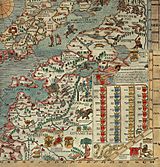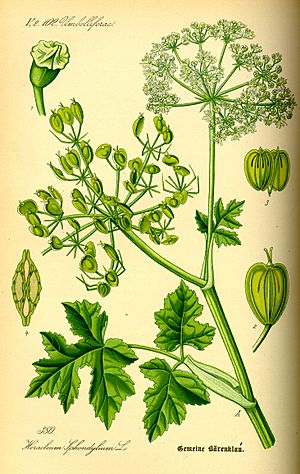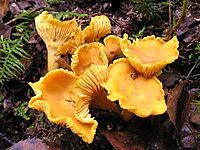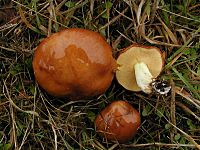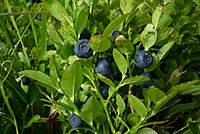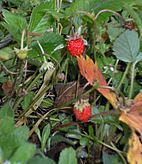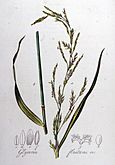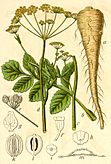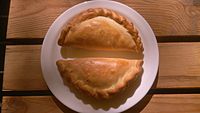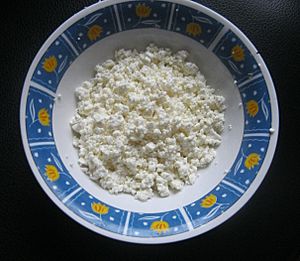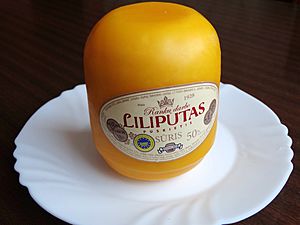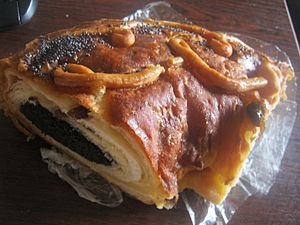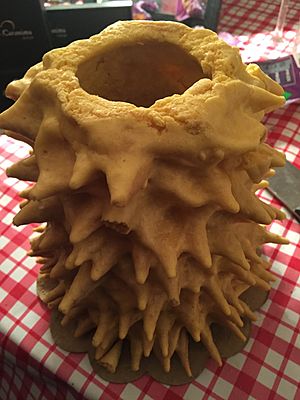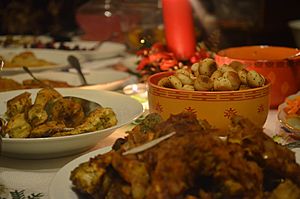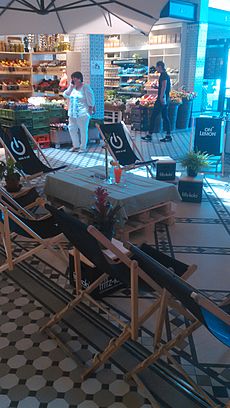Lithuanian cuisine facts for kids
Lithuanian cuisine is all about foods that grow well in a cool, wet climate. Think barley, potatoes, rye, beets, greens, berries, and mushrooms. Dairy products like cheese and sour cream are also super important! To keep food fresh for winter, Lithuanians used lots of pickling methods. Soups are very popular and are believed to be great for your health. Because Lithuania shares its climate with other northern countries, its food has a lot in common with its neighbors.
Lithuanian food traditions grew from farming and gathering wild foods over many years. It was also shaped by different cultures throughout history. For example, German traditions brought us pork and potato dishes like kugelis (potato pudding) and vėdarai (sausages stuffed with mashed potato). The fancy Šakotis cake, which looks like a tree, also came from German influences. French chefs working for Lithuanian noblemen introduced French cuisine ideas. One unique influence is from the Eastern Karaite people, who brought the tasty kibinai pastry to Lithuania. Lithuanians and other groups living in the Grand Duchy of Lithuania also shared many dishes and drinks. In turn, Lithuanian cooking even influenced Polish and Ruthenian (old Ukrainian and Belarusian) foods.
Contents
- How Lithuanian Food Changed Over Time
- What is Lithuanian Bread Like?
- Vegetables and Spices in Lithuanian Cuisine
- Finding Food in Nature: Foraging
- Fruits Grown in Lithuania
- Meat Dishes in Lithuania
- Fish in Lithuanian Cooking
- Delicious Dairy Products
- Food from Different Regions of Lithuania
- How Meals are Served
- Popular Lithuanian Dishes
- Popular Lithuanian Drinks
- Food for Special Occasions
- Modern Lithuanian Food and Restaurants
- See also
How Lithuanian Food Changed Over Time
The first records of Baltic people's food and farming come from around 98 AD. A writer named Tacitus noted that they were very good at growing grain and other crops.
In the 800s, a traveler named Wulfstan of Hedeby saw that people in the Baltic region drank mead, a drink made from honey. He said, "There is a great deal of honey and fishing. The king and the most powerful men drink mare's milk, the poor men and the slaves drink mead."
By the 1300s, almost all the grains and legumes we know today were grown in Lithuania. Rye was the most popular because it grew well in the northern climate. In one old fort called Maišiagala, archaeologists found about 20 types of grains and legumes from the 13th-14th centuries. These included rye, wheat, barley, oats, millet, buckwheat, lentils, and peas.
In the Middle Ages, hunting was the main way to get meat. It's known that Vytautas the Great, a famous Lithuanian ruler, organized a huge hunt before the Battle of Grunwald in 1410. He prepared barrels of salt-cured meat for his army. Noblemen often hunted large animals like wisents (European bison) and aurochs (a type of wild cattle) and deer. Lithuania had long wars with the Teutonic Order, but they also had diplomatic ties. They exchanged gifts, and in 1416, the Teutonic Order even sent rare wine to Anna, Vytautas the Great's wife. By this time, Lithuanian noblemen were already importing spices like saffron, cinnamon, and pepper, plus rice and raisins.
A big meeting called the Congress of Lutsk, hosted by Vytautas the Great, showed off medieval Lithuanian food. Old records say that 700 barrels of honey and wine, 700 oxen, 1,400 sheep, and hundreds of elk and wild boar were eaten every day!
Many new cooking ideas came from Italy with Bona Sforza, who became the Grand Duchess of Lithuania in the 1500s. She introduced the fork and traditional Italian foods like olives and olive oil. She also made wine and wheat flour more common. Vegetables like parsnips, cauliflowers, spinach, and even artichokes were brought in and grown. It's believed that the Palace of the Grand Dukes of Lithuania had its own special kitchen garden.
Bona Sforza's daughter, Catherine Jagiellon, later introduced the fork and other cultural habits to Sweden. Her son, Sigismund II Augustus, even had an Italian chef named Sigismondo Fanelli living in the Palace of the Grand Dukes in Vilnius.
Old records from the court of Alexander Jagiellon in the late 1400s and early 1500s mention kitchen staff. In the 1500s, a water pipe was built to bring water from Vingriai springs directly to the kitchen of the Palace of the Grand Dukes of Lithuania in Vilnius.
A sales contract from 1623 for a garden in Vilnius lists many plants grown there. These included grafted apple, pear, and plum trees, cherries, and various Italian vegetables like potatoes, artichokes, asparagus, spinach, melons, and beets. Spices like anise, peppermint, and dill were also grown. There was even a wooden orangery to grow fig-trees and walnuts. In the 1500s, Lithuanian rulers and noblemen ate imported grapes, oranges, melons, raspberries, strawberries, cherries, ginger, cinnamon, and almonds.
Potatoes started to be grown in Lithuania in the 1600s but became much more common in the 1700s.
Archaeological digs at the Palace of the Grand Dukes of Lithuania have taught us a lot about the food, cutlery, and serving styles of Lithuanian rulers.
In the 18th and 19th centuries, recipes "à la Lithuanienne" (Lithuanian style) appeared in French cookbooks. These recipes often featured game meat like moose, bear, or grey partridge, reflecting Lithuania's image of lush forests.
In the early 1900s, many girls in Lithuania went to "Trade Schools" (Amatų mokykla). Here, they learned how to cook different dishes, set tables properly, manage a household, and save money. These schools helped spread similar recipes across the country.
Today, many restaurants in Lithuania focus on historic Lithuanian cuisine, bringing old recipes back to life.
What is Lithuanian Bread Like?

One of the oldest and most important Lithuanian foods is rye bread. It was, and still is, eaten every day for breakfast, lunch, and dinner. Bread was also very important in family traditions and farming ceremonies.
The main type of bread in Lithuanian cooking is dark rye bread (ruginė duona). It's used more often than lighter wheat breads. Old archaeological finds show that bread from the 9th-14th centuries in Lithuania was very similar to the rye bread we eat today. The dough usually starts with a sourdough starter, and a little wheat flour is added to make the bread lighter. Traditionally, every home had its own sourdough yeast, called raugas, which was a symbol of the home itself.
Rye bread is often eaten as an open-faced sandwich, with butter or cheese spread on it. Sometimes, it's flavored with caraway seeds or onion. Traditional bread is baked on sweet flag leaves. Baking bread was a very important ritual. Bread was baked in a special oven called a duonkepė krosnis.
A Lithuanian proverb says, "Be aukso apsieis, be duonos ne" ("One can manage without gold, but not without bread").
Some Lithuanian breads have whole rye and wheat seeds. This type of bread is called grūdėtoji, which means "seeded" bread.
Vegetables and Spices in Lithuanian Cuisine
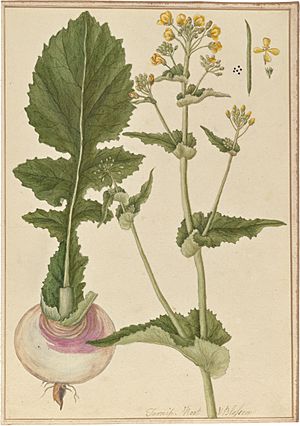
The most common vegetable in Lithuanian recipes is the potato. You can boil, bake, or sauté it, often with dill. But there are tons of different potato recipes! Potatoes came to Lithuania in the late 1700s, grew well in the climate, and quickly became a must-have food.
Cucumbers, dill pickles, radishes, and green leafy vegetables are also very popular. Beets (burokai) are grown more widely in Lithuania than in many other places. They are often used to make borscht (beet soup) and side dishes. Cabbage is another popular vegetable. It's used as a base for soups or wrapped around fillings in dishes like balandėliai. Tomatoes are available all year now, but homegrown ones from family greenhouses are still considered the best. Sorrel is grown in gardens for soup and salad.
Lithuanian herbs and seasonings include mustard seed, horseradish (krienai), dill (krapai), caraway seed (kmynai), garlic, coriander, oregano, bay leaf, juniper berries (kadagio uogos), and hemp seeds. Vanilla and pepper were hard to find during the Soviet era but were welcomed back after Lithuania became independent again. Overall, Lithuanian food is not very spicy.
Pickling is a popular way to prepare vegetables for winter or to give them a special flavor. Cucumbers, beets, dill, homegrown tomatoes, onions, and garlic are all pickled and can be found all year round.
Linseed oil was also quite popular.
Finding Food in Nature: Foraging
One special thing about Lithuanian cooking is how much it uses wild berries and mushrooms. This tradition of gathering food from nature is still very much alive today.
Mushroom picking is a popular hobby from mid-summer to autumn. Most mushrooms are gathered in the forest. Sometimes, people buy them at roadside markets, especially on the road from Druskininkai to Vilnius in the Dzūkija region. It's rare to buy mushrooms in regular shops. Even though mushrooms are a delicacy, many Lithuanians think they are hard to digest. Dried mushrooms are used to add flavor to dishes. Many types of mushrooms are picked from the wild, including:
- Baravykas – the king bolete, a very prized mushroom.
- Voveraitė (meaning 'little squirrel'), also called lepeška in the Dzūkija region – the chanterelle.
- Gudukas, vokietukas, kalpokas, vištelė – the gypsy mushroom.
The Baravykas is the most valued mushroom. It's mainly used for drying and marinating. Dried baravykas has a strong, pleasant smell and is used to flavor soups and sauces. Voveraitė is often used fresh in soups or sautéed. A common dish with this mushroom is voveraitė sautéed with chopped onions and potatoes. Gudukas is usually marinated. Other edible mushrooms like lepšė (Leccinum scabrum) and raudonviršis (Leccinum aurantiacum) are rarer but are also gathered and used in similar ways.
Wild berries are also gathered or bought at roadside markets or shops. Bilberries (mėlynės) and lingonberries (bruknės) are the most common wild berries. Cranberries (spanguolės) are valued, but they only grow in certain wet, boggy areas. Sour cranberry or lingonberry jam and sweet bilberry jam are excellent sauces for pancakes (blynai). Lingonberry jam is sometimes used as a sauce for fried chicken or turkey. Fresh bilberries can be added to a cold milk soup. Wild strawberries (žemuogės) are quite rare and are usually eaten right after they are picked.
- Foraging
-
Chanterelles are popular mushrooms in Lithuania.
-
Pastinaca sativa (paprastasis pastarnokas) was a popular food before potatoes appeared. K. Donelaitis, a famous Lithuanian writer, encouraged growing parsnips in his poem The Seasons.
Fruits Grown in Lithuania
Apples, plums, and pears grow well in Lithuania and are the most common fruits used. Fruits like citrus, bananas, and pineapples have to be imported because they can't handle the cold weather. In the past, they were not used as often, but now they are widely eaten. During the autumn harvest, fruits are often cooked slowly with spices to make fruit stews, called kompots.
Gooseberries (agrastai) and currants (serbentai) are grown a lot. They are sweetened, made into jams, used in baked goods, and add a tangy flavor to desserts. Small local farms make delicious fruit wines from raspberries and especially blackcurrants. Apple ice wine is also produced. Apple cheese, which is a type of fruit preserve, is very popular in autumn. The oldest apple cheese recipe in Lithuania was found in a 17th-century cookbook belonging to the Radziwiłł family. Sea buckthorn is used for juice and as a garnish.
Meat Dishes in Lithuania


The most common meat eaten in Lithuania is pork, followed by beef, lamb, chicken, turkey, and duck. For quick meals, meat is often grilled or coated in breadcrumbs and sautéed, similar to a schnitzel. For larger gatherings, oven roasts are prepared.
While preserving meat isn't as urgent as it was during the Soviet era or earlier times, many favorite techniques are still used. These include brining (soaking in salt water), salting, drying, and smoking. There are many types of smoked pork, including ham and a soft sausage with large pieces of filling. These are served as a main course or sliced thin in sandwiches.
Skilandis is a very popular Lithuanian sausage. Its traditional way of making it is protected in the EU and UK as a "Traditional Speciality Guaranteed" food. The art of smoking meat has a long history in Lithuania. Choosing the right wood, heat, and distance from the fire required great skill. Skilandis was smoked for four weeks in a special room called a kaminas, which was also used for cooking. Smoking, curing, and other meat preparation methods are different in various regions of Lithuania.
Fish in Lithuanian Cooking
Freshwater fish, except for herring, used to be the most popular fish in Lithuania. Fish like pike, zander, or perch are often baked whole or stuffed. Herring is marinated, baked, fried, or served in aspic (a savory jelly). Since the 1800s, herring has been imported to Lithuania from Norway. Salmon is also a popular dish, often served with a cream sauce, vegetables, and rice. Before dams were built after the Soviet occupation, salmon was quite common in Lithuanian rivers.
Smoked fish, such as eel or bream, are popular main dishes and appetizers in areas near the Baltic Sea, especially in Neringa.
Crayfish are also popular and are usually eaten in the summertime as a special treat, often served with beer.
Delicious Dairy Products
Lithuania is known for its high-quality dairy products. Dairy plays a big role in Lithuanian cooking. Curd cheese (similar to cottage cheese) can be sweet, sour, seasoned with caraway seeds, fresh, or aged until it's semi-soft. Lithuanian butter and cream are especially rich. Sour cream is so important in Lithuanian food that it's eaten with almost everything: meat, fish, pancakes, soups, desserts, salads, and more! The sour cream called Žemaitiškas kastinys is protected in the EU and UK as a "Traditional Speciality Guaranteed" food.
Lithuanian curd snacks called sūreliai are also popular. You can find many different types of soured milk products in supermarkets, but some people still prefer to make their own. There's even a "Milk Road" route that takes you through important milk production sites in Lithuania.
Milk and Its Products
There's a wide variety of milk products: milk, buttermilk, soured milk, kefir, cream, and yogurt. The most traditional are buttermilk and soured milk, often eaten with boiled potatoes.
Lithuanian Cheeses
The traditional Lithuanian curd cheese, Lietuviškas varškės sūris, is protected in the EU and UK as a "Protected Geographical Indication" (PGI). The most popular way to eat Lithuanian non-fermented white cheese is with fresh honey. It can also be cooked with spices and enjoyed with tea. Food historians believe that curd cheese has been known for 4,000-6,000 years!
Lithuanians started making hard cheese around the 1500s in the Samogitia region. Outside of Samogitia, this cheese was known as Lithuanian cheese. Historically, there weren't many types of cheese in Lithuania because fewer people had lactose intolerance. Milk products were usually eaten fresh or only slightly fermented.
The semi-hard cheese Liliputas was registered as an EU "Protected Geographical Indication" (PGI) in 2015. Hard cheese Džiugas ripens for at least 12 months and is popular among food lovers, used to add flavor to recipes. Džiugas was also registered as a Protected Geographical Indication in 2019. In the time between the two World Wars, the town of Šėta was famous for its cheese, which was made in a sūrinė (cheese house).
Small family farms across Lithuania also make various types of artisan cheeses, which are sold at eco-markets, farmer's markets, and restaurants.
Food from Different Regions of Lithuania
Lithuania has five main regions: Lithuania Minor (Mažoji Lietuva), Samogitia (Žemaitija), Aukštaitija, Suvalkija, and Dzūkija. Each has its own special foods.
Lithuania Minor was famous for its fish, mostly freshwater fish. It was smoked, salted, roasted, and dried. The best fish soup in Lithuania, similar to a French Bouillabaisse, is also made in Lithuania Minor.
Samogitia is known for its many types of porridge, crayfish, kastinis (a sour cream spread), and a herring-onion soup called cibulinė.
Aukštaitija is known for its potato dishes and vėdarai (potato sausages). Northern Aukštaitija is especially known for its beer.
Suvalkija is famous for its high-quality smoked meat products. Different types of wood are used to get a subtle taste, and some products are smoked for up to a month.
Dzūkija, the most forested region, is famous for mushrooms, berries, and buckwheat dishes like buckwheat cake (grikinė boba) and boletus mushroom soup. Meat curing by smoking is not common in Dzūkija. Instead, salted cuts of meat are kept in brine or hung and air-dried.
Different types of wood were used for smoking meat. In Samogitia and Aukštaitija, alder wood mixed with juniper was used. In Suvalkija, only alder wood was used.
How Meals are Served
Here's how a full Lithuanian meal is usually served, especially during celebrations:
- Cold Table
First, you'll find slices of cold meats (charcuterie), small salads, and herring. This part of the meal is usually cold. Many different cold dishes will be served, and you might have a bitter liquor as an appetizer.
- Soup
Soup is a very important part of Lithuanian cuisine. Even though it's not the main dish, it's meant to be pleasant and refreshing.
- Main Dish
The main dish is served hot. It could be roasted chicken, beef, or a special dish the host is proud to share. Beer or wine will be offered with the main dish.
- Dessert
Dessert is served some time after the main dish. It might be a cake or curd cheese with berries or jam.
- Coffee or Tea
Coffee or tea can be served with dessert or separately.
- Digestive Drink
If guests are still at the table having good conversations, a digestive drink or more coffee or tea might be offered.
The daily meal schedule was also influenced by ancient farm life. A typical workday was split into three parts: work from early morning until breakfast (pusryčiai), work between breakfast and dinner (pietūs), and work between dinner and the evening meal (vakarienė). Breakfast was considered the most filling meal, dinner was lighter, and the evening meal was the lightest. In summer, when workdays were longer, a light meal before breakfast (priešpusryčiai) and a meal before dinner and the evening meal (pavakariai) were provided. Even today, Lithuanians tend to eat a hearty breakfast and a very light evening meal.
Popular Lithuanian Dishes
Starters and Side Dishes
- Kepta duona (garlic bread) – Dark bread fried in oil and rubbed with garlic. It's often served with beer or other alcoholic drinks. It's a bit like French garlic bread.
- Įdaryti kiaušiniai – Hard-boiled eggs are cut in half, filled, and decorated. They are similar to deviled eggs.
- Įdaryti pomidorai – Tomatoes are cut in half and filled with a savory (tasty, not sweet) stuffing.
- Piršteliai prie alaus – These "little fingers" are thin, rolled-up puff pastries served with beer.
- Lašiniai (lard) – This is smoked pork fat, sometimes with a small layer of meat. It's a popular appetizer in villages where it's made locally. It's usually eaten as a sandwich with unbuttered dark rye bread and onions, horseradish, or other vegetables. Spirgai (cracklings) are made from lard and used for various sauces, similar to gravy. You can find different types of lašiniai in almost every butcher shop or supermarket in Lithuania.
Soups and Main Dishes
- Bulvinių kukulių sriuba – A soup with small balls made from minced potatoes, boiled in milk. These are usually made from the same potato mix used for cepelinai.
- Cabbage soup (kopūstienė) – Flavored with carrots, ham, onions, sauerkraut, or all of these, and boiled with lard.
- Cucumber soup – The broth is blended with cucumbers and sweet or sour cream, often decorated with dill.
- Juka – A blood soup from the southern region of Lithuania.
- Lapienė – Greens like sorrel or spinach are cooked slowly and added to a creamy broth.
- Kankolienė, zacirka – Milk soup with dough balls made from flour or potato.
- Sauerkraut soup – Often seasoned with pork, carrots, onions, and bay leaves.
- Barščiai – Hot borscht (beet soup). It can be served plain or mixed with sour cream or buttermilk. Sometimes, chopped Boletus mushrooms are added.
- Šaltibarščiai – A cold summer soup made with beets and milk kefir or sour milk. It's a striking pink color! It's made with cooked or pickled shredded beets and other chopped vegetables like cucumber, dill, or green onions. Hot boiled potatoes, cold sour cream, and diced hard-boiled eggs are often served on the side to add color, texture, and temperature contrast. An older, traditional version of šaltibarščiai was simply white, without beets.
- Vištienos sultinys – Chicken broth is always popular, especially for older or sick people.
- Maltiniai or Frikadėlės (Frikadeller) – Soft patties made from minced meat and onion. They are often served with potatoes, sliced cucumber, dill pickle, or grated beets and a sauce.
- Manų Putra/Košė – Semolina wheat porridge or pudding topped with butter, cinnamon, sugar, or berries. It's common for breakfast or as a dessert.
- Šaltiena or košeliena (aspic or meat jelly) – Many savory foods are served in gelatin molds. Horseradish is often served with it.
- Blynai or Lietiniai, Sklindžiai – While blynai are often called pancakes, they are usually more like crepes. They can be very thin, like crepes, or made from a yeast-risen batter, often mixed with grated apple or potato.
-
-
- Kėdainių blynai – Pancakes made from grated raw potatoes, similar to latkes.
- Žemaičių blynai – Similar to Kėdainių blynai, but made from boiled potatoes and filled with chopped cooked meat.
- Lietiniai – Large, usually square, thin crepes filled with minced meat, curd cheese with cinnamon, or minced sautéed mushrooms.
- Buckwheat pancakes – A traditional dish in Dzūkija.
-
- Balandėliai (meaning 'little doves') – Cabbage leaves stuffed with meat and cooked slowly.
- Dešra – Sausages are made in many ways: smoked or fresh, and can include pork, beef, potatoes, or barley. In rural areas, blood might be added.
- Didžkukuliai or Cepelinai (meaning 'zeppelins') – Large potato dumplings stuffed with meat, mushrooms, or cheese. They are often topped with spirgai (fried minced onion and bacon) or sour cream.
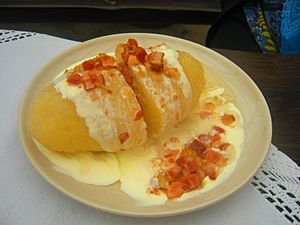
- Kastinys – A special sour cream "butter." Sour cream is kneaded and washed until it forms a soft spread. This is a traditional dish in Samogitia.
- Kibinai – A pastry filled with mutton and onions. This is a dish from the Karaite people.
- Kukuliai - Potato dumplings similar to gnocchi.
- Koldūnai, virtiniai, Auselės – These are different kinds of dumplings, filled with minced meat, sausage, cottage cheese, or mushrooms. They are usually topped with crumbled fried bacon. They are similar to Polish pierogi or kołduny, but usually smaller. Koldūnai were brought to Lithuania by Tatars, who were invited to settle by Vytautas the Great.
- Šaltanosiai - Literally "cold nose ones." Similar to koldūnai or virtiniai, these are eaten lukewarm or cold with blueberry jam. The Lithuanian name šaltanosiais was borrowed into Polish, German, and Belarusian languages.
- Kugelis (also called bulvių plokštainis, meaning "flat potato dish," or banda in the Dzūkija region) - A potato pudding made with grated potatoes and eggs. It's usually served with sour cream or spirgai (fried bacon bits). It can also be served with diced bacon and onion cooked in the bacon fat.
- Šaltnosiukai (meaning 'cold little noses') – Dumplings filled with lingonberries. You won't find these anywhere else outside Lithuania!
- Skilandis or Kindziukas – A pig stomach stuffed with meat and garlic, then cold-smoked.
- Suktiniai (meaning 'beef birds') – Beef or pork is pounded very thin, filled, rolled up, and cooked slowly. An example is zrazai, which are Lithuanian beef rolls.
- Švilpikai - Oven-baked potato snaps.
- Šiupinys (meaning 'Hodge-Podge') – A stew made from various ingredients like groats, peas, beans, potatoes, meat, and rye flour. Different regions of Lithuania prefer different combinations.
- Troškinti rauginti kopūstai – A stew made with sauerkraut and the cook's choice of meats and vegetables.
- Vėdarai – The large intestine of a pig stuffed with grated potato mash (bulviniai vėdarai) or with a mixture of pork blood, barley groats, and dried mint (Kraujiniai vėdarai).
Desserts
Lithuanian-style cakes (pyragas) are often baked in a rectangular pan and sometimes have apples, plums, apricots, or other fruits baked inside. They are usually not iced as much as cakes in other countries. These cakes are cut into squares for serving. Poppy seed is sometimes used as a swirled filling in sweet breads (Poppy seed roll and šimtalapis) and to flavor other pastries.
For special events, tortes might be prepared. These often have 10 to 20 layers, filled with jam and vanilla, chocolate, mocha, or rum buttercreams. They are decorated beautifully. Lithuanian coffeehouses (kavinė) offer a variety of tortes and pastries to attract people enjoying an evening stroll.
Desserts include:
- Žagarėliai (also known as krustai or chrustai) – Twisted, thin, deep-fried pastries dusted with powdered sugar. They are similar to Scandinavian Klejner cookies and Mexican buñuelos.
- Kūčiukai or šližikai – Very small baked rolls served with poppy seed milk. This is a traditional dish for Kūčios (Christmas Eve).
- Ledai - ice cream is served everywhere in the summer.
- Spurgos – A Lithuanian version of doughnuts, sometimes filled with preserves. The main difference is that the Lithuanian version uses curd cheese as a base. So, they are often called varškės spurgos – 'curd doughnuts'.
- Šakotis (also called raguotis) – This is a pound cake grilled layer by layer, with a very unique branching shape. It's a Lithuanian type of spit cake, similar to the German Baumkuchen or the Swedish spättekaka. Some people believe it was invented by the Yotvingians, an ancient Baltic tribe. Šakotis is often a centerpiece at Lithuanian weddings and big celebrations.
- Šimtalapis (meaning 'one hundred sheets') – This pastry was brought to Lithuania by Tatars, who were invited by Vytautas the Great. It was changed a bit locally and is made from laminated dough with layers of melted butter, similar to a croissant.
- Tinginys – Made with biscuits or crackers, cocoa, butter, sugar, and solidified milk.
- Skruzdėlynas (meaning 'anthill') – This dessert has individual pastries stacked on top of each other, sprinkled with poppy seeds, and glazed with honey and nuts.
- Fresh cucumbers with honey – A typical summer dessert, especially in the countryside.
Popular Lithuanian Drinks
Beer
Alus (beer) is super popular all over Lithuania, especially since the country regained its independence in 1990. Several Lithuanian beers have even won international awards! Local breweries are thriving. Lithuania has a long history of making farmhouse beer, with the first mentions in records from the 1000s. Beer was brewed for ancient Baltic festivals and rituals. The ancient Lithuanian god for brewing beer and mead was Ragutis or Rūgutis. September 21st was a special festival day called Alutinis, Koštuvės, or Ragautuvės, when the first beer from the year's harvest was made.
Lithuania isn't famous worldwide for its beer, but it's one of the few European countries with its own unique beer traditions. Traditional farmhouse brewing has continued to this day. During Soviet times, this type of brewing started to grow on a larger scale. After independence, this trend sped up, and soon there were over 200 breweries! Many have closed since then, but Lithuania still has about 80 breweries. About 60-70 of these make beers in styles not found anywhere else in the world. Some are very similar to the traditional brews made by farmers, while others have grown from that tradition into larger regional breweries.
Farmhouse brewing survived better in Lithuania than almost anywhere else. Because of historical events, Lithuanians then developed a commercial brewing culture from their special farmhouse traditions. In 2015, Lithuania was among the top 5 countries in Europe for beer consumption per person, with 75 active breweries, including 32 microbreweries.
The microbrewery scene in Lithuania has been growing in recent years. Many bars focusing on these beers have opened in Vilnius and other parts of the country. Local beers have even started to get international attention. Beer bloggers discovered the country, leading to a big article in Beer Connoisseur magazine. The New York Times even listed Lithuania as one of the 42 best places to visit in 2013, thanks to its village beers! You can even go on beer tours through the main breweries in northern Lithuania.
Midus (Mead)
Midus is said to be the oldest Lithuanian alcoholic drink. It's a type of mead made from honey. Baltic people have been making midus for thousands of years. One of the first times Balts and mead were mentioned was by the 9th-century traveler Wulfstan of Hedeby, who visited the Prussians. Old Lithuanian mead was made from honey and water, simmered with various spices like thyme, lemon, cinnamon, cherries, linden blossoms, juniper berries, and hops.
The oldest recipe for Lithuanian midus was written down in a book by Olaus Magnus called Historia de Gentibus Septentrionalibus, published in Rome in 1555. Midus was considered a drink for noblemen and gentry. From the 1500s, midus started to compete with imported wine, but it was still well-known and very popular in the Palace of the Grand Dukes of Lithuania. Today, Midus is produced by several companies and can be found in most liquor stores. Craft mead making is also becoming popular. The traditional Lithuanian midus called Stakliškės, which is fermented for up to 90 days, has a "Protected Geographical Indication" (PGI) label.
Fruit and Berry Wines
Fruit and berry wines are made in Lithuania by several companies. The industrial production of fruit and berry wines began in 1926 by Balys Karazija in Anykščiai. His wines won international awards in 1938. Thanks to B. Karazija's efforts, fruit wine became a traditional drink in Lithuania. Currently, smaller and larger companies produce blueberry, apple, apple ice wine, black currant, aronia, and cherry wines.
Other Drinks
- Arbata (tea) - chamomile, rosehip, thyme, and other herbal teas are popular, as is black tea. Many herbal infusions are used for health purposes. Tea parties were popular in Lithuania between the World Wars, especially among high society.
- Gira (kvass) is a non-alcoholic drink made by naturally fermenting wheat, rye, or barley bread. It's sometimes flavored with fruit, berries, raisins, or birch sap. It's similar to Russian or Ukrainian kvass. Those made from rye bread and caraway seeds are popular and sold in glass bottles. There's also a carbonated soft drink called gira sold in plastic bottles, but it doesn't taste or feel like the original drink.
- Sula (birch sap) is a traditional drink, popular in summer.
- Degtinė (meaning "the burn") is the Lithuanian version of vodka, traditionally made from rye. It's made in Lithuania, and its quality varies.
- Kava (coffee) is brewed at home using espresso makers or moka pots, or with espresso machines in cafes. It's usually quite strong and sweetened. Coffeehouses (kavinė) can be found everywhere in towns, at highway rest stops, and at tourist spots. Traditionally, Lithuanians roasted oak acorns and made gilių kava (acorn coffee) as a substitute for regular coffee beans. This is still sold in special shops as a delicacy. The first coffeehouses appeared in Lithuania in the 1700s. By 1814, there were 49 coffeehouses in Vilnius! Coffee culture was very popular in the 1800s in Lithuania. It was considered fancy to have a special room for coffee drinking and a person just for preparing coffee.
- Starka, an aged vodka, and Krupnikas, a honey liqueur, are traditional drinks from the 1500s-1700s, when Lithuania was part of the Polish-Lithuanian Commonwealth.
- Trauktinė (a bitter) is a strong herbal vodka. There are many types. It's also used as traditional medicine. Trejos devynerios ("999"), made with 27 different herbs, is one of the most famous.
- Vynas (wine) culture is growing strong in Lithuania. Wineries and special wine shops for Italian, French, and New World wines operate in the biggest cities. The wine exhibition Vyno dienos (Days of Wine), held in May, is the largest wine exhibition in Northern Europe. Lithuania has always imported wine because its climate isn't ideal for growing grapevines.
Food for Special Occasions
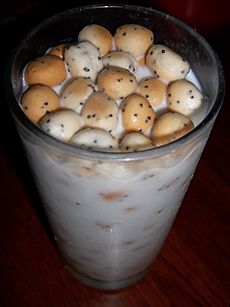
Easter and Christmas Eve are special holidays in Lithuania, each with its own unique table settings and dishes. Easter tables are often decorated with juniper or sallow twigs.
- Easter (Velykos) - The beautifully painted Easter eggs prepared earlier in the week are eaten for breakfast. People tap their eggs together as a kind of toast (among children, this sometimes turns into a smashing game!). Dinner might be roast goose or ham with side dishes. Dessert is often a cake shaped like a birch log, or cookies shaped like mushrooms.
- Birthdays (Gimtadieniai) - The family's favorite cake is served. Traditionally in Lithuania, people celebrated the day of the saint they were named after, as well as their own birth date. For example, someone named Jonas would celebrate his name day on St. John's Day (Joninės), June 23rd.
- Christmas Eve (Kūčios) - Twelve dishes are placed on a table covered with hay and lit by candles. No animal products, including dairy or eggs, can be eaten as part of this meal. However, fish is allowed and is usually part of the meal. This tradition is common in Catholic Eastern Europe, but customs vary among families. It's believed that the rituals and serving of the Christmas Eve table reflect very old Lithuanian traditions.
- Weddings (Vestuvės) - The widest possible variety of dishes are served. A special bread is sometimes baked and decorated with flowers and bird shapes, or a šakotis cake is decorated. An ideal Lithuanian wedding lasts at least two days, so a lot of cooking and baking goes on!
- Funerals (Šermenys) - The grieving family usually hosts a dinner for all the mourners at a restaurant or other venue.
- Informal Gatherings and Parties - Hosts often serve small open-faced sandwiches, similar to those at a Scandinavian smorgasbord. These are topped with smoked fish, sausage, cucumbers, and more. Flavored vodkas, which might have been made with fruits and herbs using the host's family recipe, may also be served.
Modern Lithuanian Food and Restaurants
Today, Lithuania is influenced by modern cooking trends like fusion cuisine, New Nordic food, craft beer, and craft food. The restaurant scene and fine dining are most developed in bigger cities like Vilnius, Kaunas, and Klaipėda. Every year, the "Good Food Academy" (Gero maisto akademija) selects the 30 best Lithuanian restaurants.
See also
 In Spanish: Gastronomía de Lituania para niños
In Spanish: Gastronomía de Lituania para niños





